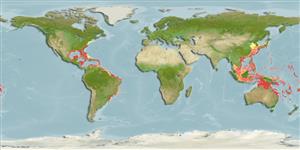Common names from other countries
Environment: milieu / climate zone / depth range / distribution range
Ecologia
marinhas associadas(os) a recifes; intervalo de profundidade 1 - 110 m (Ref. 26938), usually 10 - 50 m (Ref. 5217). Tropical; 41°N - 33°S
Western Atlantic: Canada (Ref. 5951) to New York (USA), Bermuda, and northern Gulf of Mexico to southern Brazil.
Tamanho / Peso / Idade
Maturity: Lm ? range ? - ? cm
Max length : 18.0 cm TL macho/indeterminado; (Ref. 26340); common length : 12.0 cm TL macho/indeterminado; (Ref. 5217)
Espinhos dorsais (total): 0; Raios dorsais moles (total): 76-91; Espinhos anais 0; Raios anais moles: 58 - 69. Light tan to light gray with irregular pale rings or rosettes, some of which are dark-edged; scattered small dark spots and three large blackish spots along straight portion of lateral line, the middle one the best defined (Ref. 13442).
Inhabits sandy areas with coral rubble or seagrasses, usually near patch reefs (Ref. 9710). Shallow coastal waters to depths of 110 m (Ref. 26938). Lies motionless on the bottom, moving only when frightened (Ref. 9710). Larvae are attracted to lights at night but are difficult to see because they are transparent (Ref. 26938). About one-third of the diet consists of fishes; the rest of its food is crustaceans: crabs, shrimps, amphipods, and mantis shrimps (Ref. 13442).
Life cycle and mating behavior
Maturidade | Reprodução | Desova | Ovos | Fecundidade | Larvas
Robins, C.R. and G.C. Ray, 1986. A field guide to Atlantic coast fishes of North America. Houghton Mifflin Company, Boston, U.S.A. 354 p. (Ref. 7251)
Categoria na Lista Vermelha da IUCN (Ref. 130435)
CITES (Ref. 128078)
Not Evaluated
Ameaça para o homem
Harmless
Utilização humana
Pescarias: pouco comercial; Aquário: Espécies comerciais
Mais informação
Nomes comunsSinónimosMetabolismoPredadoresEcotoxicologiaReproduçãoMaturidadeDesovaFecundidadeOvosDesenvolvimento dos ovos
ReferênciasAquaculturaPerfil para aquaculturaEstirpesGenéticaElectrophoresesHereditariedadeDoençasProcessamentoMass conversion
Ferramentas
Relatórios especiais
Descarregue XML
Fontes da internet
Estimates based on models
Preferred temperature (Ref.
115969): 21.8 - 28.9, mean 27.3 (based on 1916 cells).
Phylogenetic diversity index (Ref.
82804): PD
50 = 0.5000 [Uniqueness, from 0.5 = low to 2.0 = high].
Bayesian length-weight: a=0.00912 (0.00489 - 0.01700), b=3.06 (2.90 - 3.22), in cm Total Length, based on LWR estimates for this species & Genus-body shape (Ref.
93245).
Nível Trófico (Ref.
69278): 3.8 ±0.4 se; based on diet studies.
Resiliência (Ref.
120179): Médio, tempo mínimo de duplicação da população 1,4 - 4,4 anos (Preliminary K or Fecundity.).
Fishing Vulnerability (Ref.
59153): Low vulnerability (10 of 100).
